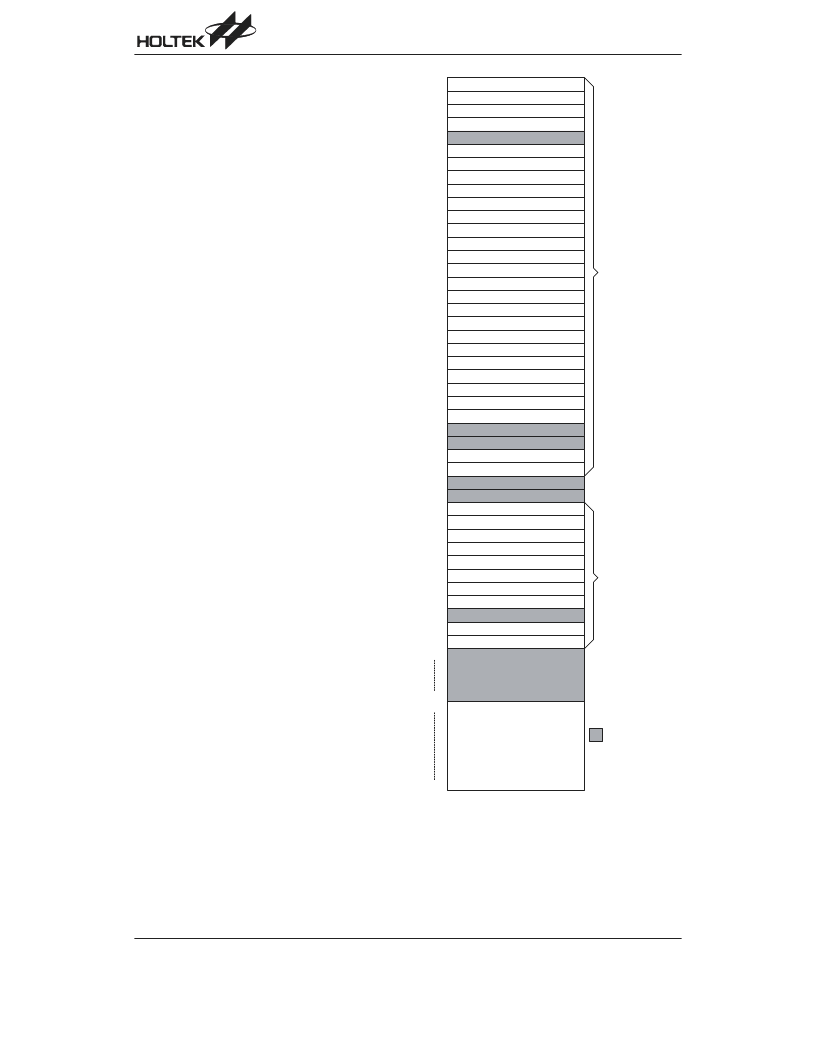- 您現(xiàn)在的位置:買賣IC網(wǎng) > PDF目錄385398 > HT36A0 (Holtek Semiconductor Inc.) 8-Bit Music Synthesizer MCU PDF資料下載
參數(shù)資料
| 型號(hào): | HT36A0 |
| 廠商: | Holtek Semiconductor Inc. |
| 英文描述: | 8-Bit Music Synthesizer MCU |
| 中文描述: | 8位微控制器音樂(lè)合成器 |
| 文件頁(yè)數(shù): | 8/23頁(yè) |
| 文件大小: | 257K |
| 代理商: | HT36A0 |
第1頁(yè)第2頁(yè)第3頁(yè)第4頁(yè)第5頁(yè)第6頁(yè)第7頁(yè)當(dāng)前第8頁(yè)第9頁(yè)第10頁(yè)第11頁(yè)第12頁(yè)第13頁(yè)第14頁(yè)第15頁(yè)第16頁(yè)第17頁(yè)第18頁(yè)第19頁(yè)第20頁(yè)第21頁(yè)第22頁(yè)第23頁(yè)

HT36A0
Rev. 1.20
8
June 18, 2003
Wavetable ROM
The ST[15~0] is used to defined the start address of
each sample on the wavetable and read the waveform
data from the location. HT36A0 provides 21 output ad-
dress lines from WA[16~0], the ST[15~0] is used to lo-
cate the major 16 bits i.e. WA[16:5] and the undefined
data from WA[4~0] is always set to 00000b. So the start
address of each sample have to be located at a multiple
of 32. Otherwise, the sample will not be read out cor-
rectly because it has a wrong starting code.
Stack Register
Stack
This is a special part of the memory which is used to
save the contents of the program counter (PC) only. The
stack is organized into 8 levels and is neither part of the
data nor part of the program space, and is neither read-
able nor writeable. The activated level is indexed by the
stack pointer (SP) and is neither readable nor writeable.
At a subroutine call or interrupt acknowledgment, the
contents of the program counter are pushed onto the
stack. At the end of a subroutine or an interrupt routine,
signaled by a return instruction (RET or RETI), the pro-
gram counter is restored to its previous value from the
stack.Afterachipreset,theSPwillpointtothetopofthe
stack.
If the stack is full and a non-masked interrupt takes
place, the interrupt request flag will be recorded but the
acknowledgment will be inhibited. When the stack
pointer is decremented (by RET or RETI), the interrupt
will be serviced. This feature prevents stack overflow al-
lowing the programmer to use the structure more easily.
In a similar case, if the stack is full and a CALLis subse-
quently executed, a stack overflow occurs and the first
entry will be lost (only the most recent eight return ad-
dress are stored).
Data Memory
RAM
Thedatamemoryisdesignedwith256
memory is divided into three functional groups: special
function registers, wavetable function register, and gen-
8bits.Thedata
eral purpose data memory (208 8). Most of them are
read/write, but some are read only.
The special function registers include the Indirect Ad-
dressing register 0 (00H), the Memory Pointer register 0
(MP0;01H), the Indirect Addressing register 1 (02H), the
Memory Pointer register 1 (MP1;03H), the Accumulator
(ACC;05H), the Program Counter Lower-byte register
(PCL;06H), the Table Pointer (TBLP;07H), the Table
Higher-order byte register (TBLH;08H), the Watchdog
Timer option Setting register (WDTS;09H), the Status
register (STATUS;0AH), the Interrupt Control register
(INTC;0BH), the Timer/event Counter 0 Higher-order
byte register (TMR0H;0CH), the Timer/event Counter 0
Lower-order byte register (TMR0L;0DH), the
Timer/event Counter 0 Control register (TMR0C;0EH),
the Timer/ event Counter 1 Higher-order byte register
(TMR1H;0FH), the Timer/event Counter 1 Lower-order
byte register (TMR1L;10H), the Timer/event Counter 1
Control register (TMR1C;11H), the I/O registers
(PA;12H,PB;14H,PC;16H,PD;18H),theprogramROM
bank select (PF;1CH)) and the I/O Control registers
(PAC;13H, PBC;15H, PCC;17H, PDC;19H), and the
"
6
.
3
'
.
#
C
%
%
%
! %
%
) %
%
%
%
* %
%
%
%
%
# %
( %
%
%
%
! %
%
) %
%
%
%
* %
%
%
%
%
# %
( %
%
%
%
! %
%
) %
%
%
* %
%
%
( %
.
3
'
.
#
C
,
.
7
/
( ( %
B .
A 2
A .
. D
D
1 A
6 .
A A
4 .
4
.
1 A
6 .
A A
4 .
4
.
&
'
&
'
& %
E
' "
" '
'
"
1 + '
'
%
'
&
'
'
%
'
&
'
(
(
.
=
.
6
(
5
6 7 .
=
.
4
. 7
(
5
6 7 .
=
. 3 @ . 7
"
. A A
.
4
. 7
"
. A A
. 3 @ . 7
.
=
.
4
. 7
.
=
. 3 @ . 7
3
3 .
4
&
0 . > 3
=
. 6 3
3
4
. > 3
= . 6 3
3
%
!
%
E
>
. (
6
3
4
RAM mapping
相關(guān)PDF資料 |
PDF描述 |
|---|---|
| HT36A1 | Music Synthesizer 8-Bit MCU |
| HT36A2 | 8-Bit Music Synthesizer MCU |
| HT36A3 | 8-Bit Music Synthesizer MCU |
| HT36A4 | 8-Bit Music Synthesizer MCU |
| HT3810 | 128 NOTE MELODY GENERATORS |
相關(guān)代理商/技術(shù)參數(shù) |
參數(shù)描述 |
|---|---|
| HT36A0(48DIP) | 制造商:未知廠家 制造商全稱:未知廠家 功能描述:Microcontroller |
| HT36A1 | 制造商:HOLTEK 制造商全稱:Holtek Semiconductor Inc 功能描述:Music Synthesizer 8-Bit MCU |
| HT36A2 | 制造商:HOLTEK 制造商全稱:Holtek Semiconductor Inc 功能描述:8-Bit Music Synthesizer MCU |
| HT36A3 | 制造商:HOLTEK 制造商全稱:Holtek Semiconductor Inc 功能描述:8-Bit Music Synthesizer MCU |
| HT36A4 | 制造商:HOLTEK 制造商全稱:Holtek Semiconductor Inc 功能描述:Music Synthesizer 8-Bit MCU |
發(fā)布緊急采購(gòu),3分鐘左右您將得到回復(fù)。